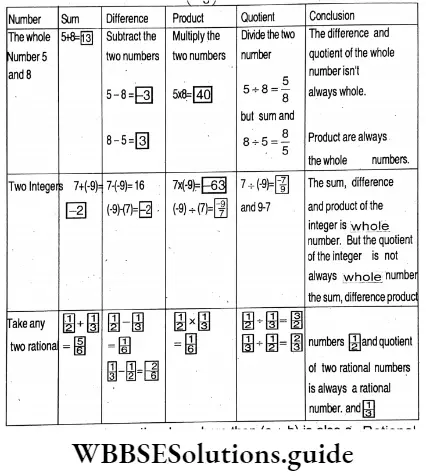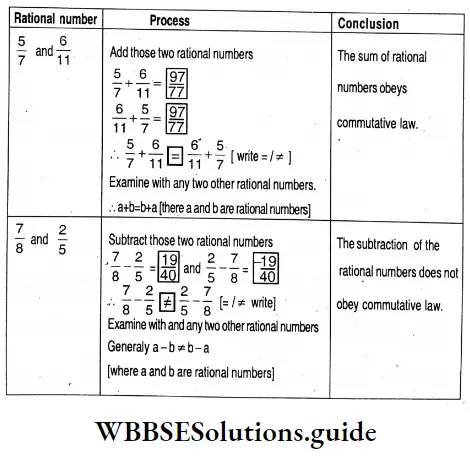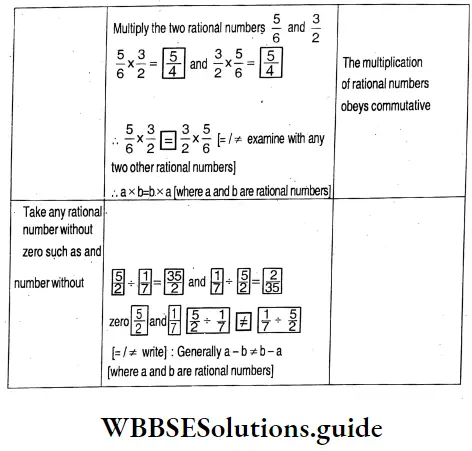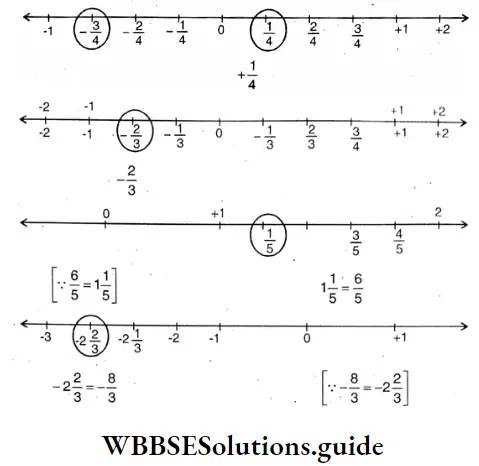Rational Numbers
The bus left at 8 o’clock in the morning. We fifteen friends have taken seats in the bus. But after some time the bus becomes crowded. Tamal shall try to write the room of the equation on a card.
Question 1. Let’s assume x more passengers other than us have boarded the bus.
Solution:
If now there are 32 passengers, then we get, x + 15 = 32 ………..(1)
or, x = 32 – 15
∴ x=17
∴ 17 more passengers have boarded the bus.
Tamal wrote on a piece of paper: The root of equation no. (1) is a natural number.
If there were 15 more passengers,
i.e., X + 15 = 15 ………….(2) then we get X = 0
Read and Learn More WBBSE Solutions For Class 8 Maths
∴ In that case the root of equation (2) is Natural Number (Natural Number / Whole number)
But Ayesha wrote by mistake X + 35 = 32.
X + 35 = 32……….(3) Let’s see what root w*e get solving the equation
X + 35 = 32
x = -3 The root of the equation (3) is – 3.
Tamal wrote the root of the equation (3) is [integer] [Integer / whole number)
Nasir also writes by mistake 2x + 15 = 32
Question 2. Let’s solve the equation 3x + 40 = 32 and find out the root.
Solution:
Given
3x + 40 = 32
or, 3x = 32 – 40
or, 3x = -8
∴ x = \(\frac{-8}{3}\)
It is seen the root of this equation is \(\frac{-8}{3}\)
\(\frac{-8}{3}\) is a Rational number.
Let’s solve the equations below :
(1) 5x = 30
Solution:
Given
5x = 30
or, x = \(\frac{30}{5}\)
or, x= 6
2. 2x + \(\frac{x-1}{2}\) = 5
Solution:
Given
2x + \(\frac{x-1}{2}\) = 5
or, \(\frac{4 x+x-1}{2}\) = 5
or, 5x-1 = 10
or, 5x = 10+1=11
or, x= \(\frac{11}{5}=2 \frac{1}{5}\)
3. \(\frac{x}{5}+\frac{2}{7}=\frac{x}{10}\)
Solution:
Given
\(\frac{x}{5}+\frac{2}{7}=\frac{x}{10}\)= \(\frac{x}{5}-\frac{x}{10}=-\frac{2}{7}\)
= \(\frac{2 x-x}{10}=-\frac{2}{7}\)
= \(\frac{x}{10}=\frac{2}{7}\)
= \(x=-\frac{2}{7} \times 10\)
= \(x=-\frac{20}{7}=-2 \frac{6}{7}\)
4. \(\frac{x}{4}+\frac{1}{2}=\frac{1}{2}\)
Solution:
Given
\(\frac{x}{4}+\frac{1}{2}=\frac{1}{2}\)or, \(\frac{x}{4}=\frac{1}{2}-\frac{1}{2}\)
or, \(\frac{x}{4}=0\)
or, x = 0
We see the root of each equation is a Rational Number.
Question 3. But let’s see which number I get if I subtract two rational numbers.
Solution:
It is seen by subtracting two rational numbers I got a Rational number.
⇒ \(\left(-\frac{2}{3}\right)-\left(\frac{3}{8}\right)=-\frac{2}{3}-\frac{3}{8}=\frac{-16-9}{24}=-\frac{25}{24}\)
Question 4. Let’s see which number I get by multiplying two rational numbers.
Solution:
⇒ \(\left(-\frac{2}{3}\right) \times\left(\frac{3}{8}\right)=-\frac{1}{4}\)
It is seen by multiplying two rational numbers I got a Rational number.
Question 5. Let’s see which number I get by dividing two rational numbers.
Solution:
⇒ \(\left(-\frac{2}{3}\right) \div\left(\frac{3}{8}\right)=-\frac{2}{3} \times \frac{8}{3}=-\frac{16}{9}\)
It is seen by dividing these two rational numbers I got a number I got a Rational number. But let’s see what I get from \(\left(-\frac{2}{3}\right) \div 0\)

If a and b are two rational numbers then (a+b) is a rational number, (a – b) or (b – a) are Rational numbers, (a x b)= Rational number. But a ÷ b is always a rational number if b ≠ 0.
Let’s see what I get by adding O with any rational numbers.
= \(0+\frac{3}{7}=\frac{3}{7}\) and \(\frac{3}{7}+0=\frac{3}{7}\).
Let’s see what I shall get by multiplying and rational number by 1,
= \(1 \times \frac{3}{7}=\frac{3}{7}\) and \(\frac{3}{7} \times 1=\frac{3}{7}\)
Sima got by adding with zero two rational numbers and multiplying two rational numbers by,
0+ any rational = + 0 = Thai rational number That rational number
1x any rational number = That rational number x 1 = That rational number i.e., 0 + a = a + 0 = a and 1 x a = a 1 = a [ There a is any rational number]
1multiply any rational numbers with 0 and see what I shall find.
= \(0 \times \frac{14}{19}=0, \quad \frac{14}{19} \times 0=0\)
∴ Dipu multiplied any two rational numbers with 0.
0 x any rational number = any rational number 0 = 0
[ Take any rational number and do myself ]
0 x a = a x 0 = 0 (Here a is any rational number).
Write understanding below the chart and see where commutative law observes.


Question 6. I take any three rational numbers and add:
Solution:
= \(-\frac{1}{5}+\left(\frac{2}{5}+\frac{5}{7}\right)=\frac{32}{35}\)
and \(\left(-\frac{1}{5}+\frac{2}{5}\right)+\frac{5}{7}=\frac{32}{35}\)
∴ \(-\frac{1}{5}+\left(\frac{2}{5}+\frac{5}{7}\right) \left(-\frac{1}{5}+\frac{2}{5}\right)+\frac{5}{7}\)
∴ \(-\frac{1}{5}, \frac{2}{5}\) and \(\frac{5}{7}\)
Question 7. Subtract with any three rational numbers and see what we get.
Solution:
⇒ \(\frac{3}{5}-\left(\frac{2}{7}-\frac{1}{4}\right)=\frac{79}{140}\)
⇒ \(\left(\frac{3}{5}-\frac{2}{7}\right)-\frac{1}{4}=\frac{9}{140}\)
∴ \(\frac{3}{5}-\left(\frac{2}{7}-\frac{1}{4}\right)\) ≠ \(\left(\frac{3}{5}-\frac{2}{7}\right)-\frac{1}{4}\)
∴The substance of the rational numbers does not obey associative law.
Generally a-(b-c) ≠ (a-b)-c [where a,b,c are three rational numbers]
Question 8. I multiply with any three rational numbers and see of the multiplication of the rational numbers obeys Associative law.
Solution:
⇒ \(\frac{5}{8} \times\left(\frac{3}{5} \times \frac{7}{9}\right)=\frac{7}{24}\) and \(\left(\frac{5}{8} \times \frac{3}{5}\right) \times \frac{7}{9}=\frac{7}{24}\)
⇒ \(\frac{5}{8} \times\left(\frac{3}{5} \times \frac{7}{9}\right)\) ≠ \(\) [=/≠write]
⇒ \(\frac{5}{8}, \frac{3}{5}, \frac{7}{9}\) obeys associative law.
Question 9. Taking any three rational numbers Shuvam examined where the multiplication of the rational numbers obeys associative law.
Solution:
We get, a×(b×c) = (a×b)×c [Where a,b,c are rational numbers ]
⇒ \(\frac{1}{2}, \frac{2}{3}\) and \(\frac{5}{6}\) are three rational numbers.
⇒ \(\frac{1}{2} \times\left(\frac{2}{3} \times \frac{5}{6}\right)=\frac{1}{2} \times \frac{5}{9}=\frac{5}{18}\)
Again, \(\left(\frac{1}{2} \times \frac{2}{3}\right) \times \frac{5}{6}=\frac{1}{3} \times \frac{5}{6}=\frac{5}{18}\)
We see that multiplication of three rational numbers obeys associative law.
Question 10. I decide any three rational numbers and see whether the division of the rational numbers obeys the commutative law of addition.
Solution:
⇒ \(\frac{11}{13} \div\left(\frac{5}{6} \div \frac{3}{8}\right)=\frac{11}{13} \div\left(\frac{5}{6} \times \frac{8}{3}\right)=\frac{11}{13} \div \frac{20}{9}=\frac{11}{13} \times \frac{9}{20}=\frac{99}{260}\)
But \(\left(\frac{11}{13} \div \frac{5}{6}\right) \div \frac{3}{8}=\left(\frac{11}{13} \times \frac{6}{5}\right) \div \frac{3}{8}=\frac{66}{65} \times \frac{8}{3}=\frac{176}{65}\)
∴ \(\frac{11}{13} \div\left(\frac{5}{6} \div \frac{3}{8}\right) \neq\left(\frac{11}{13} \div \frac{5}{6}\right) \div \frac{3}{8}\)
Division of rational numbers does not obey associative law.
Let’s see which number will be added to the rational number to make it zero.
⇒ \(\frac{3}{7}+\frac{-3}{7}=0 \text { and } \frac{3}{7}=0 \frac{-3}{7}\)
Joseph drew another card \(-\frac{2}{9}\)
⇒ \(\frac{-2}{9}+\left\{-\left(\frac{-2}{9}\right)\right\}=0\)
Adding ⇒ \(\frac{-2}{9}\) with \(-\left(\frac{-2}{9}\right)\) we get 0
⇒ \(\frac{2}{9}+\left(\frac{-2}{9}\right)=0\)
Question 12. \(\frac{9}{13}\)
Solution:
Given
\(\frac{9}{13}\)⇒ \(\frac{9}{13} \times \frac{13}{9}=1 \text { or } \frac{13}{9} \times \frac{9}{13}=1\)
i.e., if \(\frac{9}{13}\) is multiplied by the reciprocal of \(\frac{9}{13}\) or \(\frac{13}{9}\), we get 1
Appu drew 1 \(-\frac{11}{7}\) , \(\left(-\frac{11}{7}\right)\) lets write by which rational numbers
\(\left(-\frac{11}{7}\right) \times-\frac{7}{11}\) = 1 and \(-\frac{7}{11}\) × \(-\frac{11}{7}\)= 1
∴ \(a \times \frac{1}{a}\) = 1 \(\frac{1}{a} \times a\)[where a is a rational number and a≠0]
But Rana picked up → 5/7 , 7/8 , or 11/12
He wrote \(\frac{5}{2} \times\left(\frac{7}{8}+\frac{11}{12}\right)=\frac{5}{2} \times\left(\frac{21+22}{24}\right)\)
⇒ \(\frac{5}{2} \times \frac{43}{24}=\frac{215}{48}\)
But \(\frac{5}{2} \times \frac{7}{8}+\frac{5}{2} \times \frac{11}{12}=\frac{35}{16}+\frac{55}{24}=\frac{215}{48}\)
It is seen \(\frac{5}{2} \times\left(\frac{7}{8}+\frac{11}{12}\right)\) = \(\frac{5}{2} \times \frac{7}{8}+\frac{5}{2} \times \frac{11}{12}\) [write =/≠]
Rational Numbers Exercise
1. Adding \(\frac{2}{9}\) with \(-\frac{2}{9}\) we shall get
2. Adding \(-\frac{9}{8}\) with \(\frac{9}{8}\) we shall get
3. Adding \(-\left(-\frac{5}{2}\right)\) with \(-\frac{5}{2}\) we shall get zero
4. Adding \(\frac{5}{8}\) with \(\frac{8}{5}\) we shall get
5. Adding \(-\frac{3}{9}\) with \(-\frac{9}{3}\) we shall get
6. Let’s multiply \(\frac{7}{9} \times\left(-\frac{11}{25}\right) \times\left(-\frac{89}{41}\right) \times\left(\frac{5}{121}\right)\) using commutative law and associative law.
Solution:
Given
\(\frac{7}{9} \times\left(-\frac{11}{25}\right) \times\left(-\frac{89}{41}\right) \times\left(\frac{5}{121}\right)\)Using commutative law,
⇒ \(\left(-\frac{89}{41}\right) \times\left(\frac{5}{121}\right) \times \frac{7}{9} \times\left(-\frac{11}{25}\right)\)
⇒ \(\frac{-89}{41} \times \frac{5}{121} \times \frac{7}{9} \times \frac{-11}{25}\)
⇒ \(\frac{89}{41} \times \frac{5}{121} \times \frac{7}{9} \times \frac{11}{25}\)
⇒ \(\frac{623}{20295}\)
Using associative law,
⇒ \(\frac{7}{9}\left\{\left(\frac{-11}{25}\right) \times\left(\frac{-89}{41}\right) \times\left(\frac{5}{121}\right)\right\}\)
⇒ \(\frac{7}{9}\left(\frac{11}{25} \times \frac{89}{41} \times \frac{5}{121}\right)\)
⇒ \(\frac{7}{9} \times \frac{89}{2255}=\frac{623}{20295}\)
Now by dividing the distance between 0 to 1 into 5 equal parts, let put \(\frac{1}{5}\) and \(\frac{2}{5}\) at the right extremities of the first part and the second part respectively.
Dividing the distance between 0 to 1 into 5 equal parts, if I make same distance, I shall get → \(0, \frac{1}{5}, \frac{2}{5} \frac{3}{5}, \frac{4}{5} \frac{5}{5}=1\)
Again dividing the distance between 1 to 2 into 5 equal parts, I shall get → \(\frac{6}{5}, \frac{7}{5}, \frac{8}{5}, \frac{9}{5}, \frac{10}{5}=2\)
Dividing the distance between 1 into 5 equal parts, we get \(0,-\frac{1}{5},-\frac{2}{5},-\frac{3}{5},-\frac{4}{5},-\frac{5}{5}=-1\)
∴ Again dividing the distance between -2 to -1 into 5 equal parts, we get \(\frac{6}{5},-\frac{7}{5},-\frac{8}{5},-\frac{9}{5}, \frac{10}{5}=-2\)

Between and \(\frac{2}{5}\) and \(\frac{4}{5}\) let’s examine is there a rational number?
\(\frac{3}{5} \frac{2}{5}=\frac{4}{10}\) and \(\frac{4}{5}=\frac{8}{10}\)
It is seen that in between \(\frac{4}{10}\) and \(\frac{8}{10}\) we can write the rational number \(\frac{5}{10}, \frac{6}{10}, \frac{7}{10}\)
Again, \(\frac{2}{5}=\frac{4}{10}=\frac{40}{100}\) and \(\frac{4}{5}=\frac{8}{10}=\frac{80}{100}\)
∴ In between \(\frac{40}{100}\) and \(\frac{80}{100}\) we can write the rational number \(\frac{41}{100}, \frac{42}{100}, \ldots \ldots, \frac{79}{100}\)
∴ There are infinite rational numbers in between \(\frac{2}{5}\) and \(\frac{4}{5}\).
We get infinite (finite/infinite/rational numbers in between any two rational numbers.)
Rational Numbers Exercise
Question 1. Let’s solve the following equations and express the root in the form (where q≠0 and p,q are two integers)
1. 7x=14
Solution:
Given
7x=14
⇒ \(7 x=\frac{14}{7}\)
⇒ \(x=\frac{2}{1}\)
(Here p=2,q=1)
x=2
2. 4p+32=0
Solution:
Given
4p+32=0
⇒ 4p=-32
p=\(\frac{-32}{4}\)
p=\(\frac{-8}{1}\)
(Here p=-8,q=1)
p=-8
3. 11x=0
Solution:
Given
11x=0
x= \(\frac{0}{11}\)
(Here p=0,q=11)
x=0
4. 5m-3=0
Solution:
Given
5m-3=0
⇒ 5m=3
⇒ m= \(\frac{3}{5}\)
(Here p=3,q=5)
m= \(\frac{3}{5}\)
5. 9y+18=0
Solution:
Given
9y+18=0
⇒ 9y=-18
y= \(\frac{-18}{9}\)
y= \(\frac{-2}{1}\)
(Here p=-2,q=1)
y=-2
6. t=8-12t
Solution:
Given
t=8-12t
⇒ t+12t=8
⇒ 13t=8
⇒ t= \(\frac{8}{13}\)
(Here p=8,q=13)
t= \(\frac{8}{13}\)
7. 6y=5+y
Solution:
Given
6y=5+y
⇒ 6y-y=5
⇒ 5y=5
⇒ y= \(\frac{5}{5}\)
⇒ y= \(\frac{1}{1}\)
(Here p=1,q=1)
y=1
8. 2x+4=12
Solution:
Given
2x+4=12
2x+4=12
⇒ 2x=12-4
⇒ 2x=8
⇒ x= \(\frac{8}{2}\)
⇒ x= \(\frac{4}{1}\)
(Here p=4,q=1)
x=4
Question 2. let’s verify if y=\(\frac{-5}{4}\) then \(\frac{-5}{4}\) = y.
Solution:
y= \(y=\frac{-5}{4}\)
L.H.S. = -(-y)
= \(-\left\{-\left(\frac{-5}{4}\right)\right\}\) = \(-\left\{\frac{5}{4}\right\}=-\frac{5}{4}\) = Y = R.H.S.(proved).
1. 2x+5
Solution:
Given 2x + 5
= \(2\left(-\frac{3}{8}\right)+5\)
= \(-\frac{3}{4}+\frac{5}{1}\)
= \(\frac{-3+20}{4}=\frac{17}{4}\)
2. x+ \(x+\frac{3}{8}\)
Solution:
Given x+ \(x+\frac{3}{8}\)
⇒ \( x+\frac{3}{8}\)
= \(-\frac{3}{8}+\frac{3}{8}\)
= 0
3. 5-(-x)
Solution:
Given 5 – (-x)
⇒ \(5-\left\{-\left(-\frac{3}{8}\right)\right\}\)
⇒ \(5-\left\{\frac{3}{8}\right\}\)
⇒ \(5-\frac{3}{8}\)
⇒ \(\frac{40-3}{8}\)
⇒ \(\frac{37}{8}\)
⇒ \(4 \frac{5}{8}\)
4. 6-(-x)
Solution:
Given 6 – (-x)
= \(6-\left\{-\left(-\frac{3}{8}\right)\right\}\)
= \(6-\left\{\frac{3}{8}\right\}\)
= \(6-\frac{3}{8}\)
= \(\frac{48-3}{8}\)
= \(\frac{45}{8}\)
= \(5 \frac{5}{8}\)
Question 4. Let’s write the appropriate number in the following boxes:
Solution:
1. \(\frac{9}{11}+-\frac{9}{11}=0 \)
2. \( \frac{21}{29}+\left(-\frac{21}{29}\right)=0\)
3. \(\frac{7}{19} \times \frac{19}{7}=1\),
4. \(-5 \times-\frac{1}{5}=1\)
5. \(\frac{-15}{23} \times-\frac{23}{15}=1\)
6. (\(\left(-\frac{8}{3}\right) \times\left(-\frac{21}{20}\right)=\frac{14}{15}\)
Question 5. Multiplying \(\frac{7}{18}\) with the reciprocal of \(\left(-\frac{5}{6}\right)\), lets write the product.
Solution:
Reciprocal of \(-\frac{5}{6}\) is = \(-\frac{6}{5}\)
∴ \(\frac{7}{18} \times\left(-\frac{6}{5}\right)\)
= \(-\frac{7}{18} \times \frac{6}{5}\)
= \(-\frac{7}{15}\)
Question 6. Find the value of the following with the help of commutative law and associative law.
Solution:
1. \(\frac{5}{8}+\left(-\frac{7}{15}\right)+\left(\frac{3}{32}\right)+\left(\frac{11}{75}\right)\)
Solution:
Given \(\frac{5}{8}+\left(-\frac{7}{15}\right)+\left(\frac{3}{32}\right)+\left(\frac{11}{75}\right)\)
⇒ \(\left(\frac{5}{8}+\frac{3}{32}\right)+\left(\frac{11}{75}-\frac{7}{15}\right)\)
⇒ \(\left(\frac{20+3}{32}\right)+\left(\frac{11-35}{75}\right)\)
⇒ \(\frac{23}{32}+\left(-\frac{24}{75}\right)\)
⇒ \(\frac{23}{32}-\frac{8}{25}\)
⇒ \( \frac{575-256}{800}\)
⇒ \(\frac{319}{800}\)
2. \(\frac{8}{121} \times \frac{35}{169} \times \frac{55}{36} \times \frac{78}{49}\)
Solution:
Given \(\frac{8}{121} \times \frac{35}{169} \times \frac{55}{36} \times \frac{78}{49}\)
⇒ \(\left(-\frac{8}{121} \times \frac{55}{36}\right)\) × \(\left(\frac{35}{169} \times \frac{78}{49}\right)\)
⇒ \(\frac{10}{99} \times \frac{30}{93}\)
⇒ \(\frac{100}{3003}\)
Question 7. Let’s put the rational numbers in the number line: \(\frac{1}{4},-\frac{3}{4},-\frac{2}{3}, \frac{6}{5},-\frac{8}{3}\)
Solution:

Question 8. 4 rational numbers which age greater than rational numbers.
Solution:
⇒ \(\frac{1}{2}, 1 \frac{1}{3}, 1 \frac{1}{4}, 1 \frac{1}{5}\)
Question 9. Let’s find 4 rational numbers between and \(\frac{3}{5}\) \(4 \frac{1}{2}\). \(-\frac{3}{5}=-\frac{6}{10}, \frac{1}{2}=\frac{5}{10}\)
Solution:
⇒ \(-\frac{3}{5}=-\frac{6}{10}, \frac{1}{2}=\frac{5}{10}\)
Between \(\frac{-6}{10}\) and \(\frac{5}{10}\) rational numbers are
⇒ \(\frac{-5}{10},-\frac{4}{10},-\frac{3}{10},-\frac{2}{10},-\frac{1}{10}, 0, \frac{1}{10}, \frac{2} {10}, \frac{3}{10}, \frac{4}{10}\)
Or, \(-\frac{1}{2},-\frac{2}{5}\) \(-\frac{3}{10}, \frac{1}{5},-\frac{1}{10}, 0, \frac{1}{10}, \frac{1}{5}, \frac{3}{10}, \frac{2}{5}\)
Question 10. We write five rational numbers between the two rational numbers given below.
Solution:
1. \(\frac{1}{3}\) and \(\frac{3}{5}\)
Solution:
Given \(\frac{1}{3}\) and \(\frac{3}{5}\)
\(\frac{1}{3}=\frac{5}{15}=\frac{10}{30}, \frac{3}{5}=\frac{9}{15}=\frac{18}{30}\)]
= 10
2. Between \(\frac{1}{3}\) and \(\frac{3}{5}\) we five rational numbers:
Solution:
Given \(\frac{1}{3}\) and \(\frac{3}{5}\)
⇒ \(\frac{11}{30}, \frac{12}{30}, \frac{13}{30}, \frac{14}{30}, \frac{15}{30} \text { or, } \frac{11}{30}, \frac{2}{5}, \frac{13}{30}, \frac{7}{15}, \frac{1}{2}\)
3. \(\frac{1}{4}\) and \(\frac{1}{2}\)
Solution:
Given \(\frac{1}{4}\) and \(\frac{1}{2}\)
⇒ \(\frac{1}{4}=\frac{6}{24}\) and \(\frac{1}{2}=\frac{12}{24}\)
Between \(\frac{1}{4}\) and \(\frac{1}{2}\) we five rational numbers are
⇒ \(\frac{7}{24}, \frac{8}{24}, \frac{9}{24}, \frac{10}{24}, \frac{11}{24} \text { or } \frac{7}{24}, \frac{1}{3}, \frac{3}{8}, \frac{5}{12}, \frac{11}{24}\) and \(\)
4. \(\frac{4}{3}\) and \(\frac{3}{7}\)
Solution:
Given \(\frac{4}{3}\) and \(\frac{3}{7}\)
⇒ \(\frac{4}{3}=\frac{4 \times 7}{3 \times 7}=\frac{28}{21}\)
⇒ \(\frac{3}{7}=\frac{3 \times 3}{7 \times 3}=\frac{9}{21}\)
Between \(\frac{3}{7}\) and \(\frac{4}{3}\) we five rational numbers are
⇒ \(\frac{10}{21}, \frac{11}{21}, \frac{12}{21}, \frac{13}{21}, \frac{14}{21}\)
⇒ \(\frac{10}{21}, \frac{11}{21}, \frac{4}{7}, \frac{13}{21}, \frac{14}{21}\)

